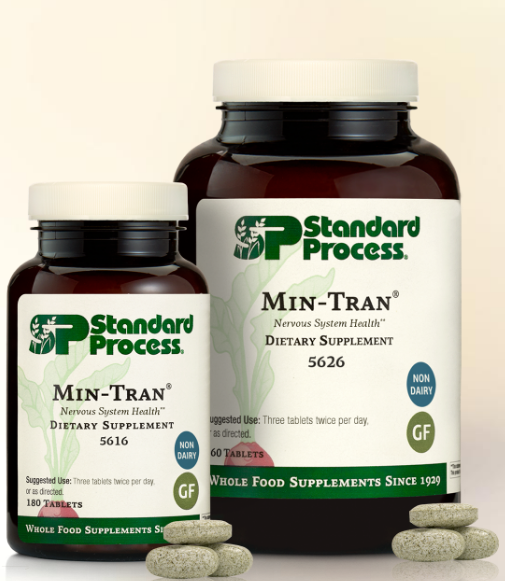Standard Process
Min-Tran®
Couldn't load pickup availability
Min-Tran®
Introduced in 1960
Min-Tran, a vegetarian nervous system support supplement, is a good source of magnesium, which supports the actions of neurotransmitters that help regulate mood.*
- A good source of magnesium, which may play a role in the stress response pathway
- A good source of magnesium, which is involved in sleep pathways that support brain homeostatic sleep processes*
- Excellent source of iodine
- Good source of calcium
This product is now available in medium oval tablets (rather than small tablets) which has reduced the total recommended quantity of tablets per day. The cost per day remains the same.
Benefits of Min-Tran
Min-Tran contains magnesium and iodine. Both these minerals support a healthy nervous system*, and magnesium also supports processes that help to regulate mood and sleep.*
How Min-Tran Works to Support a Healthy Nervous System
Thyroid Health
Iodine is an essential component of thyroid hormone, which regulates many important biochemical reactions, including protein synthesis and enzymatic activity.1 Thyroid hormone is also required for the developing central nervous system and supports energy metabolism in brain cells.1-2
Nerve Transmission
Calcium and magnesium are essential for a number of metabolic functions, including nerve transmission.3 Calcium signals within and between cells to relay messages, including nerve impulses by triggering the release of neurotransmitters.4 When a nerve impulse reaches its target site (a muscle or other nerve cells), a rush of calcium ions enter the nerve, which increases the concentration of calcium ions in the cell and triggers the release of neurotransmitters to carry the impulse across the synapse to the target cells.4 Magnesium supports nerve conduction by aiding in the active transport of calcium across cell membranes.5,6
How Magnesium Supports the Body
Sleep Processes
Magnesium is an N-methyl-d-aspartate (NMDA) receptor blocker which may help regulate mood and may support healthy sleep and sleep homeostasis.1-13
Magnesium is also an agonist to the y-amino butyric acid (GABA) receptor, and activation of the GABA receptor has been shown to be involved with support healthy sleep processes and healthy mood pathways.14-16
Stress Response Pathway
Magnesium may play a role in the stress response pathway through regulation of catecholamines. Here’s how it may work: a stressor (either physical or psychological) activates the hypothalamic-pituitary- adrenal (HPA) axis and the autonomic nervous system leading to the release of catecholamines, which may be regulated by magnesium.17,18
Stress depletes the body’s sources of magnesium, resulting in hypomagnesemia. Hypomagnesemia, also known as magnesium deficiency, happens when you have a lower-than-normal level of magnesium in your blood.20 This increases susceptibility to stress, which can alter the release of compounds responding to stress, including neurotransmitters.
References:
- Supplements, N.1.o.H.O.o.D. Iodine (Fact Sheet for Health Professionals). (2021).
- Rao, T.S.S., et al. (2008). Indian J Psychiatry, 50:77.
- Cuciureanu, M.D., Vink, R. in Magnesium in the Central Nervous System (eds. Vink, R. & Nechifor, M.) (University of Adelaide Press© 2011 The Authors., Adelaide (AU), 2011).
- Institute of Medicine (US) Committee to Review Dietary Reference Intakes for Vitamin D and Calcium; Ross AC, T.C .. Yaktine AL, et al .. editors. Dietary Reference Intakes for Calcium and Vitamin D. Washington (DC): National Academies Press (US) (2011).
- Carvil, P., Cronin, J. (2010). Strength Cond J, 32:48.
- Elin, R.J. (2010). Magnes Res, 23:S194.
- Kollinska, J., Liljequist, S. (1998). L-701,324. Psychopharmacology (Berl). 135:175.
- Plaznik, A., et al. (1994). Eur Neuropsychopharmacol, 4:503.
- Poleszak, E., et al. Pharmacol Biochem Behav, 78:7.
- Blanke ML, V.A. Chapter 13: Activation Mechanisms of the NMDA Receptor, (CRC Press/ Taylor & Francis, Boca Raton (FL), 2009).
- Campbell, 1.G .. Feinberg, I. (1996). J Neurophysiol, 76:3714.
- Campbell, I.G., Feinberg, I. (7999). Sleep, 22:423.
- Held, K., et al. (2002). Pharmacopsychiatry, 35:135.
- Schwartz, R.D., et al. (1994). J Neurochem, 62:916.
- Poleszak, E. (2008). Pharmacol Rep, 60(4):483,
- Faulhaber, J., Steiger, A .. Lancel, M. (7997). Psychopharmacology (Berl), 130:285.
- Amyard, N., et al. (1995). Magnes Res, 8:5.
- Pinto, J.E. (7979). Horm Metab Res, 11 :404.
- Pickering, G., et al. (2020) Nutrients, 12(12):3672.
- https://my.clevelandclinic.org/health/diseases/23264-hypomagnesemia


